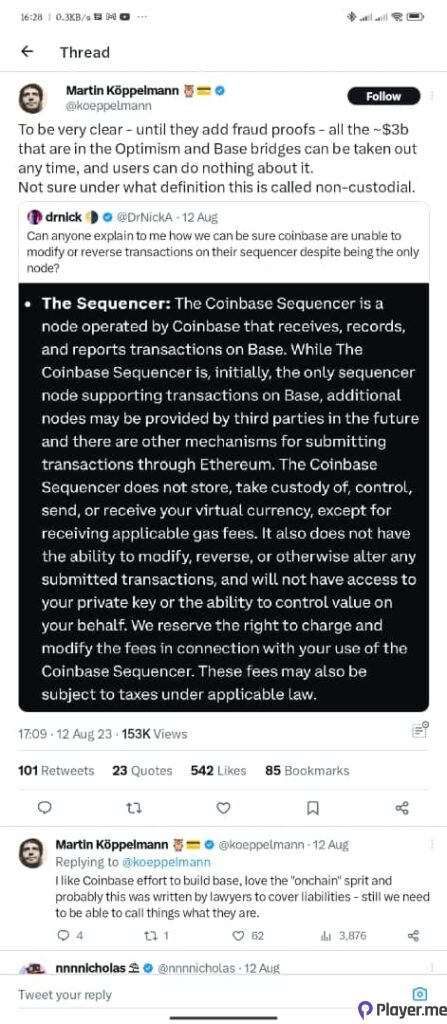OP Labs, a leading crypto developer, has taken a significant stride in bolstering the security of its distributed networks built on the Ethereum blockchain. This pivotal move addresses a glaring deficiency in the institution’s software – the absence of “Fault proofs”. This article will delve into the importance of fault proofs, OP Labs’ quest to integrate them, and the broader implications for the blockchain ecosystem.
Also Read: Blockchain Technology for Secure and Transparent Business Transactions
The Quest for Fault Proofs

OP Labs’ software has been instrumental in enabling businesses, including heavyweight Coinbase, to establish their own distributed networks on the Ethereum blockchain. However, the absence of fault proofs, a critical component of optimistic roll-up technology, left these networks vulnerable.
Fault proofs, also known as fraud proofs, are pivotal in verifying data integrity in Layer-2 blockchains or “Roll-ups” connected to primary Layer-1 blockchains like Ethereum. OP Labs recognised the significance of this security feature and initiated the “Cannon” project to rectify this issue.
Security Concerns and Roll-up Technology
The absence of fault proofs in roll-up technology has been a concern among blockchain experts. Transactions executed in networks without fault proofs are deemed insecure and susceptible to manipulation, as seasoned Ethereum developer Martin Köppelmann highlighted.
Responding to criticism and security concerns, OP Labs adopted a multi-pronged approach. Karl Floersch, CEO of OP Labs, emphasised the importance of governance and decentralisation as prerequisites for implementing fault proofs.
OP Labs is committed to achieving stage 2 decentralisation, a crucial milestone in developing blockchain projects. In February, the company embarked on an architectural mapping process to decentralise specific elements of its protocol, laying the groundwork for a more secure and resilient blockchain ecosystem.
Read more on blockchain and security at https://player.me/blockchain-and-cybersecurity-a-powerful-duo/.
Fault Proofs Implementation
OP Labs has introduced fault proofs on its test network, OP Goerli Testnet, marking a significant step toward enhancing the security of its distributed networks. This development addresses the concerns raised by experts in the crypto community. It underscores OP Labs’ commitment to safeguarding blockchain integrity.
The Importance of Fault Proofs
Fault proofs, often fraud proofs, are integral to the security and trustworthiness of blockchain networks. Here’s why they matter:
Preventing Fraud and Ensuring Data Integrity
Fault proofs are cryptographic mechanisms that help verify the accuracy and authenticity of data on a blockchain. They safeguard against fraudulent activities, ensuring that transactions and smart contracts are executed as intended. In the absence of fault proofs, the risk of malicious actors manipulating data and compromising the integrity of a blockchain network increases significantly.
Enhancing Security in Layer-2 Solutions
Layer-2 scaling solutions, such as optimistic roll-ups, rely heavily on fault proofs to maintain security while improving transaction throughput. These solutions are designed to offload some processing from the primary blockchain (Layer 1) to secondary layers (Layer 2). Fault proofs provide the necessary checks and balances to ensure that Layer-2 data remains secure and aligned with the state of the Layer-1 blockchain.
Building Trust in Blockchain Ecosystems
Trust is a foundational element of blockchain technology. Users and businesses rely on the immutability and security of blockchain data. Fault proofs contribute to this trust by offering a transparent and verifiable way to validate blockchain transactions. When implemented effectively, fault proofs instil confidence in the blockchain ecosystem, attracting more participants and investment.
The Implementation Process
OP Labs’ journey toward implementing fault proofs was neither quick nor straightforward. It involved careful planning, development, and testing to ensure the highest level of security and reliability.
Karl Floersch, CEO of OP Labs, emphasised that the recent development resulted from extensive redesign efforts initiated over a year ago. The company had to rethink its system’s design from the ground up to ensure long-term sustainability.
Furthermore, deploying fault proofs on the test network, or “Testnet”, is only the first step toward implementing them on the OP Stack. OP Labs has plans to expand its capabilities to accommodate “Zero-knowledge” proofs. This promising cryptographic technology could serve as an alternative to fault proofs.
Security Concerns in the Crypto Space
The cryptocurrency and blockchain space has witnessed tremendous growth and innovation over the past decade. However, with this growth comes increased scrutiny and security challenges.
The absence of fault proofs in blockchain projects like those powered by OP Labs raised concerns among industry experts. The potential for vulnerabilities and exploits without robust security measures is a valid worry, especially given the significant value locked into these networks.
Martin Köppelmann, a long-time Ethereum developer and co-founder of the Gnosis blockchain, tweeted in August when Coinbase’s Base went live that until fault proofs are added, “All the ~$3 billion that are in the Optimism and Base bridges can be taken out any time, and users can do nothing about it”.

This tweet underscored the urgency of addressing the security gaps in blockchain networks, particularly those reliant on optimistic roll-up technology.
The Role of Governance and Decentralisation
Karl Floersch, CEO of OP Labs, is acutely aware of the criticism regarding the absence of fault proofs. However, he believes blockchain projects must address governance and decentralisation to ship fault proofs.
In the blockchain world, governance refers to the decision-making processes determining how a blockchain network evolves and adapts over time. Decentralisation, on the other hand, is a core principle that seeks to distribute power and control across a network rather than concentrating it in the hands of a few.
Floersch’s perspective is grounded in the understanding that achieving robust governance and decentralisation is a prerequisite for ensuring the long-term security and sustainability of blockchain networks. Without these foundational elements, fault proofs alone may not be sufficient to protect against all potential threats.
OP Labs’ Path to Decentralisation
OP Labs’ commitment to governance and decentralisation is evident in its actions. The company embarked on an architectural mapping process in February to decentralise specific elements of its protocol.
This initiative is a critical step toward achieving stage 2 decentralisation. This milestone signifies a more secure and resilient blockchain ecosystem. While the specifics of OP Labs’ decentralisation efforts are yet to be fully disclosed, the company’s dedication to blockchain development is clear.
Conclusion
OP Labs’ implementation of fault proofs signifies a critical enhancement in the security of its distributed networks. As the blockchain ecosystem continues to evolve, fault proofs, coupled with a focus on governance and decentralisation, play a pivotal role in ensuring the safety and integrity of blockchain networks.
The journey toward greater security in blockchain technology is ongoing, and OP Labs has taken a substantial step in the right direction. Just as driving a fast car without airbags is unthinkable, securing blockchain networks without fault proofs is equally essential for the crypto landscape’s future.
Frequently Asked Questions
What’s the Purpose of Optimism’s Fault-Proof System Alpha?
Optimism’s fault-proof system alpha comprises a Fault-Proof Program (FFP), a Fault-Proof Virtual Machine (FPVM), and a dispute game protocol. Its primary goal is to safeguard the Optimism network by preventing fraudulent activities or errors in roll-up transactions. The system works in tandem to challenge malicious activity, providing additional security to the network.
How Does the Dispute Game Protocol Work, and What’s the Role of Bonding?
The dispute game protocol allows users to challenge potentially fraudulent transactions. However, during the testnet release, there won’t be incentives for participation, as bonding design will be added ahead of the OP mainnet launch. Bonding refers to the amount a sequencer must post as collateral. The sequencer’s bond is slashed and redistributed to verifiers if fraud is proven.
How Does Optimism’s Fault-Proof System Contribute to Layer-2 Decentralisation?
Fault proofs are a crucial step in achieving a permissionless transition of information between layer 1 and layer 2. They enable users to deposit tokens into layer 2 from layer 1 and withdraw tokens from layer 1 without external interference. Notably, tokens directly deployed to layer 2 do not depend on the fault-proof system, maintaining the highest security and decentralisation properties of layer 1. This approach paves the way for faster decentralisation and user opt-out capabilities.
Author Profile
Latest entries
 GAMING2024.06.12Top 4 Female Tekken 8 Fighters to Obliterate Your Opponents in Style!
GAMING2024.06.12Top 4 Female Tekken 8 Fighters to Obliterate Your Opponents in Style! NEWS2024.03.18Elon Musk’s SpaceX Ventures into National Security to Empower Spy Satellite Network for U.S.
NEWS2024.03.18Elon Musk’s SpaceX Ventures into National Security to Empower Spy Satellite Network for U.S. GAMING2024.03.17PS Plus: 7 New Games for March and Beyond
GAMING2024.03.17PS Plus: 7 New Games for March and Beyond GAMING2024.03.17Last Epoch Necromancer Builds: All You Need To Know About It
GAMING2024.03.17Last Epoch Necromancer Builds: All You Need To Know About It





